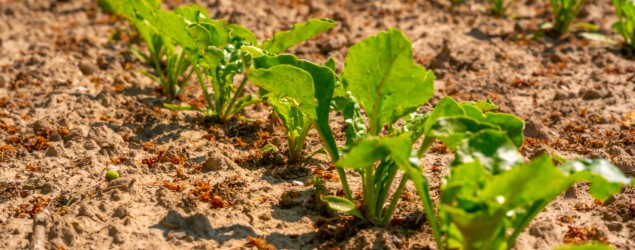The cultivation of white beet in Poland holds a fixed and stable position in the sowing structure. The size of the cultivation acreage is approx. 200 thousand ha and has been subject to slight fluctuations over the last few years.
The useful yield of sugar beet consists of its roots. Whereas the aboveground part, i.e. the leaves together with part or all of the head, are now green fertilizer and are plowed in. In the past, after the ensilage process, they were being used as feed.
The factor that significantly affects the yield of roots, their sugar content and, consequently, the sugar yield is the length of the growing season. In Poland, this period is 180-200 days. The factor limiting the length of this period is the seedling temperature, which is 6°C at a depth of 10cm in the soil. From seedling to inter-row closure, the beet must accumulate approx. 700°Cd. The minimum biomass accumulation temperature is 3°C, but the optimal range is within the range of 15-20°C. Beetroot requires fertile and abundant soils of high thickness. In crop rotation, it usually takes place after the grain forecrop. White beet reacts very favorably to all forms of organic fertilization, from manure to plowed or mulched aftercrops.
Among the macronutrients, sugar beet accumulates the greatest amount of potassium (approx. 42% of the total accumulated ingredients), sodium (13%), nitrogen (24%), phosphorus (7%), calcium (8%) and magnesium (6%). The ratio of basic nutrients in the fertilization of sugar beet is as follows:
N : P2O5 : K2O : Na2O
1 : 0,3 : 1,75 : 0,55
Calcium and magnesium, which constitute 14% of the total accumulated ingredients, have a smaller impact on the root yield and to a greater extent on sugar yield (especially white sugar). Among the micronutrients, iron and manganese are accumulated the most, and copper - the least. The proportion of the micronutrients for sugar beet is as follows:
Fe : Mn : Zn : B : Cu
30 : 11 : 5 : 5 : 1
The total fertilization needs of white beet are high and result from the large total yield of the mass-produced, exceeding 100t per hectare. Nitrogen is the key nutrient in the initial stage of growth. Its presence in sufficient quantity guarantees to build a correct, well-developed leaf rosette. Later on, this state of affairs will result in the intensive production of sugars in photosynthesis and their accumulation in the storage organ - the root. This period of optimal nitrogen nutrition should last until the closing of inter-rows. From this stage of growth, the plant's nitrogen supply should drop, and by the end of the growing season, the beet should be functioning in a state of slight nitrogen "starvation". The excess nitrogen at this time results in excessive development of the above-ground part at the expense of the storage root.
The second, and first in terms of accumulation, an essential ingredient in the fertilization of white beet is potassium. The demand for this nutrient first increases linearly to pass from the middle of the growing season to a parabolic function with a decrease at the end of vegetation. The role of potassium in beet is due to the physiological functions of the plant, which are related to:
- regulation of nitrogen uptake,
- water management control,
- sugar accumulation control,
- control of the stress resistance mechanisms in crops.
The yield-generating effect of calcium and magnesium is based on the nitrogen conversion mechanism on the one hand and on the development of the root system on the other, which is thus able to take up more nutrients and water from the soil. Additionally, as a central component of chlorophyll, magnesium is responsible for the production of chlorophyll-rich leaves in the appropriate stage, capable of binding CO2. During the ripening stage, magnesium affects the accumulation of sugar in the storage root.
Fertilization technologies
Taking into account the different expectations of farmers in terms of crop nutrition, we have prepared for you three complete proposals for foliar fertilization.
The following technologies have been prepared in response to these expectations, in order to optimally nourish the crop and are for reference. If you have any questions regarding the details of the technology and the adjustment of the individual dosage of the indicated products, we invite you to contact our Team.
















